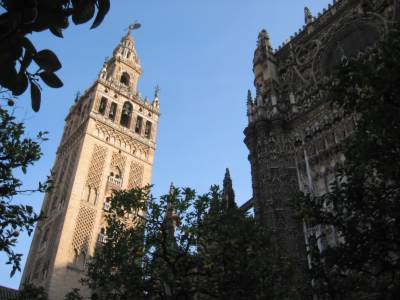
Seville's cathedral--the biggest in the world, says the Guinness Book of Records--was built on the site of Moorish Seville's main mosque between 1401 and 1506. The structure is primarily Gothic, though most of the internal decoration is in later styles. The adjoining tower, La Giralda, was the mosque's minaret and dates from the 12th century.

Cathedral and bell tower above the orange trees. In 1401, the 12th-century Almohad mosque was destroyed to clear space for a massive cathedral. All that remains is the Patio de Los Narajos, where the faithful would wash before prayer, and the famed minaret La Giralda, built in 1198.

Orange tree courtyard (Patio de Los Naranjos) of the cathedral, Sevilla.

Cathedral of Sevilla. Legend has it that the reconquistadores in 1401 wished to demonstrate their religious fervor by constructing a church so great, they said, that "those who come after us will take us for madman." With 44 individual chapels, the Cathedral of Sevilla is the third largest in the world, after St. Peter's Basilica in Rome and St. Paul's Cathedral in London, and the world's biggest Gothic edifice ever constructed. It took more than a century to build.

Cathedral of Sevilla.

The retablo mayo (altarpiece), one of the largest in the world, is a golden wall of intricately wrought saints and disciples.

Sepulcro de Cristobal Colon (Christopher Columbus' supposed tomb). The four black and gold crowned sepulchre-bearers represent the eternally grateful monarchs of Castilla, Leon, Aragon, and Navarra, four kingdoms of Spain at the time of Columbus' sailing.

Columbus tomb in the Cathedral of Sevilla. There's considerable mystery surrounding the actual whereabouts of Columbus's remains, since he has four alleged resting places throughout the world. The sepulcro was inaugurated in 1902, 396 years after Columbus died.

Courtyard view from the adjoining tower, La Giralda, of the cathedral. The climb up La Giralda affords great views.

Sevilla's alcazar, a residence of Muslim and Christian royalty for many centuries, was founded in the 10th century as a Moorish fortress. It has been adapted by Seville's rulers in almost every century since, which makes it a mish-mash of styles, but adds to its fascination. Now this palace serves as the residence of the King and Queen of Spain during their stays in Sevilla.

The royal baths of Pedro the Cruel's lady friend-- are found beneath one of the palaces.

Wall tiles in the gardens of Alcazar, Seville.

Street of Sevilla at night.

Tapa bars of Sevilla in the early evening. Still early.

Sevilla.

Plaza de Espania, Sevilla.

Sevilla (Seville) at night.

No comments:
Post a Comment